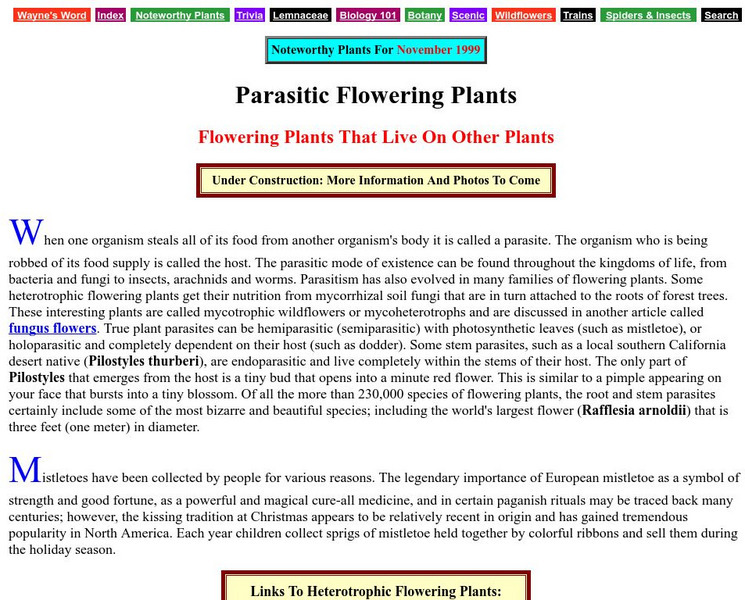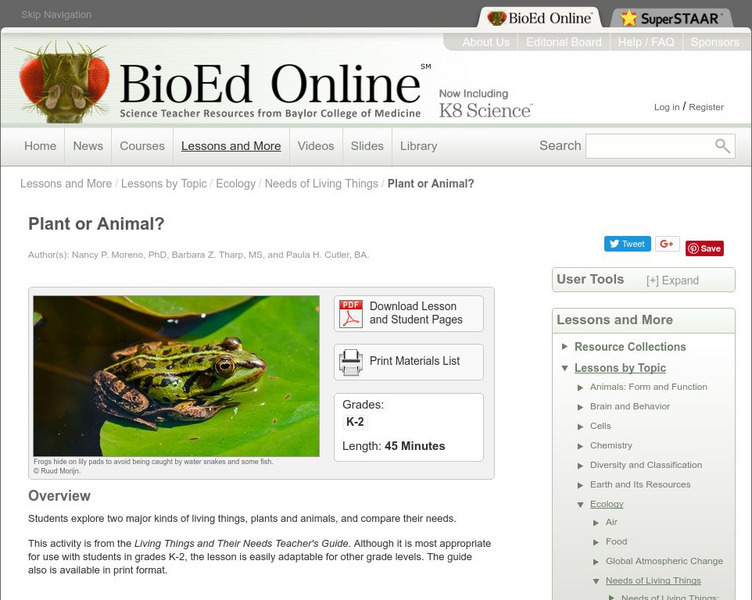National Center for Ecological Analysis and Synthesis, University of California Santa Barbara
Kids Do Ecology: Temperate Grasslands
At the National Center for Ecological Analysis and Synthesis, you can learn where temperate grasslands are located! Other information includes grassland weather, plants, animals, people, and more.
National Center for Ecological Analysis and Synthesis, University of California Santa Barbara
Kids Do Ecology: Savanna
Learn where savannas are located! Other information at the site from the National Center for Ecological Analysis and Synthesis includes grassland weather, plants, animals, people, and more.
National Center for Ecological Analysis and Synthesis, University of California Santa Barbara
Kids Do Ecology: Biomes
At this site from National Center for Ecological Analysis and Synthesis you will find the answers to many questions about biomes. You will also find a listing of biomes along with a detailed explanation of each.
Palomar Community College District
Palomar College: Parasitic Flowering Plants
The ecology and natural history of plants that live at the expense of other organisms is described in detail at this site from the Palomar College. Great material for a report or presentation.
BioEd Online
Bio Ed Online: Needs of Plants
Each student will make his/her own mini-garden and will observe the growth and development of radishes. To help young scholars learn about requirements for plant growth, the teacher will make four experimental gardens and place them in...
CK-12 Foundation
Ck 12: Life Science: 7.10 Seed Plants
Learn the characteristics and ecology of seed plants.
National Center for Ecological Analysis and Synthesis, University of California Santa Barbara
Nceas: Kids Do Ecology: Freshwater Wetlands
Find out about the plants, animals, people, and location of freshwater wetland ecosystems.
Michigan State University
Michigan State University: Digital Learning Center for Microbial Ecology: Microbe Zoo: Ag Acres
A simple overview of the important roles microbes play in agriculture. You'll learn how some microbes can be hazardous to plants while others help fertilize and build soil, and kill insects.
Encyclopedia of Earth
Encyclopedia of Earth: Botany: Mangrove Ecology
Extensive article on mangroves. Covers classification, physical characteristics, life cycle, habitat, economic value, and natural and human threats to their survival.
Curated OER
National Park Service: Alien Plant Invaders of Natural Areas
A virtual who's who of invasive plants, herbs, vines, shrubs, and trees. This comprehensive site provides easy-to-read fact sheets that contain native ranges, plant descriptions, ecological threats, U.S. distributions & habitats,...
BioEd Online
Bio Ed Online: Living Things and Their Needs: Plant or Animal?
In this instructional activity, young scholars investigate and compare the needs of plants and animals. The instructional activity can be downloaded in PDF format.
BioEd Online
Bio Ed Online: Plant Parts You Eat
Did you know that some plant parts are edible? People rely on many different plants and plant parts for food. In this lesson students observe and investigate different plant-originated foods, and learn about plant parts.
PBS
Nh Pbs: Nature Works: Temperate Deciduous Forests
NatureWorks offers some fascinating information about the Temperate Deciduous Forests. Students and teachers will learn what makes these forests special, what animals live in this biome, what plants grow in this biome, and more.
Science Education Resource Center at Carleton College
Serc: Ecosystem Study
Studets investigate the health of an ecosystem and the effects of water, sunlight, nutrients or pollutants. They determine the change in the environment through observation, journaling, and measuring growth of the plants and living...
Science Education Resource Center at Carleton College
Serc: Courtyard Observations One Small Step
Students observe a one square foot area to make detailed observations of plants, animals, and insects outdoors in the school courtyard.
University of Hawai'i
Hvnp: Mid Elevation Woodland& Succession on 1974 Flow
Students can take a virtual tour of a Hawaiian volcano which erupted in 1974. Pictures show plants starting the succession process occurring along a pahoehoe flow.
University of California
Ucmp: Plantae
At this resource learners can take a look at the plant kingdom with a detailed examination of fossil records, life history and ecology, systematics, and morphology.
Nature Research
Nature Education: Energy Economics in Ecosystems
This article discusses how plants and microorganisms, until recently, have mostly controlled how much carbon dioxide is released into an ecosystem, and explains how this process works. Humans' burning of fossil fuels has upset the...
Science Education Resource Center at Carleton College
Serc: Studying Eco Climatic Domains
After learning about the climates of different ecological regions of the United States, students investigate the impact of climate change on plants that live in those regions. By looking at changes over time, they can better understand...
Encyclopedia of Earth
Encyclopedia of Earth: Microbiology: Virus
Article explaining what viruses are, their evolution, taxonomy, morphology, and replication. Also covers mechanisms by which viruses cause disease, how they can impact on plants, and the potential and real benefits we get from...
University of California
Ucmp: Aves Life History and Ecolog
University of California Berkeley offers a good discussion of the natural role that birds play and the importance of this role to man.
Environmental Education for Kids
Eek!: Activity: Trees and Air Quality
Site offers lessons and activities designed to supplement study of the environment and ecology. Concise explanations are presented on the importance of trees in our world. Also, problem solving and creative thinking is encouraged...
Science Education Resource Center at Carleton College
Serc: Our Big Backyard: How Does Our Local Ecosystem Change During the Year?
Get students observing the environment around their school with this activity. In this lab experiment, students keep a journal containing written observations and digital pictures of how local flora and fauna change during the school year.
Other
Earth's Birthday Project: Educating About the Earth
This site is loaded with science activities for elementary students. There are role plays, recipes, dances, writing exercises and craft ideas. You can also raise you own luna moths, praying mantids, ladybugs or carnivorous plants. Lots...























